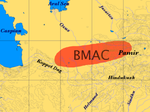Vedic Sanskrit has a number of linguistic features which are alien to most other Indo-European languages. Prominent examples include: phonologically, the... 29 KB (3,449 words) - 06:35, 10 April 2024 |
 | Harappan language (category Languages extinct in the 13th century BC) civilization would be historical substratum influence, in particular the substratum in Vedic Sanskrit. The Indus script only indicates that it was used to... 10 KB (957 words) - 22:36, 12 April 2024 |
Substrata (redirect from Substratum) languages which influence another through linguistic contact Substratum in Vedic Sanskrit Stratum (disambiguation) Strata (disambiguation) Substrate (disambiguation)... 739 bytes (119 words) - 17:18, 5 December 2023 |
Pre-Greek substrate (redirect from Pre-Greek substratum) Substratum in Vedic Sanskrit Duhoux 2007a, pp. 220–222. Beekes 2014, pp. 47–48: "Our knowledge of Indo-European has expanded so much, especially in the... 43 KB (4,262 words) - 11:22, 21 April 2024 |
 | Linguistic history of India (section Vedic Sanskrit) 11th century. India portal Substratum in Vedic Sanskrit Persian language in the Indian subcontinent Indo-Aryan loanwords in Tamil Linguistic Survey of... 79 KB (9,262 words) - 20:41, 18 April 2024 |
grammarians from the later Vedic period (roughly 8th century BCE), culminating in the Pāṇinian grammar of the 4th century BCE. Sanskrit grammatical tradition... 48 KB (4,549 words) - 04:47, 8 April 2024 |
Substratum in Vedic Sanskrit The word baga is attested once in Old Avestan (possibly, but its interpretation remains unclear), and about ten times in... 27 KB (860 words) - 08:38, 22 April 2024 |
language#Fricatives. From treaties of Mitanni. From Kikkuli. Kikkuli Sindoi Substratum in Vedic Sanskrit Mitanni Gutian language Kümmel 2022, p. 246. Sigfried J. de Laet... 13 KB (1,171 words) - 04:20, 5 April 2024 |
 | Bactria–Margiana Archaeological Complex (category Archaeological cultures in Afghanistan) same language, which are only attested in Indo-Aryan and therefore evidence of a substratum in Vedic Sanskrit. He explains this by proposing that Indo-Aryan... 59 KB (6,909 words) - 10:04, 13 April 2024 |
Desi words (category Sanskrit words and phrases) migrations. Substratum in Vedic Sanskrit Mesthrie, Rajend (2018). "A Sociolinguistic History of Bhojpuri-Hindi in South Africa". Language in Indenture.... 2 KB (157 words) - 05:22, 14 December 2023 |
 | Kirtan (category Articles containing Sanskrit-language text) performers Nama sankeerthanam Raga Sikh music Substratum in Vedic Sanskrit Vedic Sanskrit Vedic chant Vedic period Ananda Lal (2009). Theatres of India:... 46 KB (4,964 words) - 19:07, 26 February 2024 |
 | Sinhala language (redirect from Substratum in Sinhala) branching syntax and the loss of aspirated stops in Sinhala is attributed to a probable South Dravidian substratum effect. This has been explained by a period... 43 KB (4,170 words) - 05:01, 11 April 2024 |
preserved by Sanskrit, especially the older form of Indo-Aryan termed Vedic Sanskrit. In Proto-Indo-European, a new system developed wherein an intermediary... 64 KB (4,685 words) - 00:32, 3 April 2024 |
Akasha (category Articles containing Sanskrit-language text) "sky". The word in Sanskrit is derived from a root kāś meaning "to be".[citation needed] It appears as a masculine noun in Vedic Sanskrit with a generic... 6 KB (700 words) - 20:25, 15 April 2024 |
 | Dravidian peoples (category Articles containing Sanskrit-language text) non-Vedic in origin and have been dated either as post-Vedic texts or as pre-Vedic compositions. The Agamas are a collection of Tamil and Sanskrit scriptures... 84 KB (7,575 words) - 16:58, 5 April 2024 |
Vibhu (category Sanskrit words and phrases) Vibhu (Sanskrit:विभु) means – 'mighty', 'powerful', 'eminent', 'supreme', 'able to', 'capable of', 'self-subdued', 'firm' or 'self-controlled'; in Nyaya... 11 KB (1,141 words) - 13:04, 9 May 2023 |
Ālambana (section Vedic implication) Ālambana (Sanskrit:आलम्बन), is a Sanskrit term which variously means – support, foundation, supporting, base, sustaining, cause, reason, basis, or the... 9 KB (920 words) - 16:17, 4 March 2024 |
Rasa (aesthetics) (category Articles containing Sanskrit-language text) In Indian aesthetics, a rasa (Sanskrit: रस) literally means "juice, essence or taste". It is a concept in Indian arts denoting the aesthetic flavour of... 27 KB (3,025 words) - 03:17, 2 April 2024 |
 | Lingam (category Articles containing Sanskrit-language text) such as the "indicative sign is in a Vedic passage". According to Doniger, there is persuasive evidence in later Sanskrit literature that the early Indians... 100 KB (10,359 words) - 05:48, 20 April 2024 |
Shauraseni Prakrit (category Articles containing Sanskrit-language text) same linguistic substratum as other Dramatic Prakrit varieties. It may be based on the spoken vernacular around the 2nd century BC in the ancient state... 2 KB (193 words) - 08:52, 23 April 2024 |
 | Meluhha (section Meluhhan trading colony in Sumer) a substratum (including loanwords) in Dravidian languages. Asko Parpola relates Meluhha with Mleccha who were considered non-Vedic "barbarians" in Vedic... 36 KB (3,341 words) - 20:06, 15 April 2024 |
languages of modern India all go back to Vedic Sanskrit (or dialects very closely related to it), which has been preserved in texts accurately handed down by parallel... 13 KB (1,689 words) - 00:06, 11 January 2024 |
(and functioning) of the body. They consist of: Rasa dhatu (lymph) the substratum formed just after the digestion of food. The main function of this Dhatu... 2 KB (204 words) - 13:30, 14 March 2024 |
 | Konkani language (category All Wikipedia articles written in Indian English) old Indo-Aryan vernacular languages, which may be loosely related to Vedic Sanskrit; others still spoke Dravidian and Desi dialects. Thus the ancient Konkani... 103 KB (11,352 words) - 23:37, 22 April 2024 |
Proto-Dravidian from Rig Vedic akṣa. The following words are attested in both Proto-South Dravidian and Rig Vedic Sanskrit (circa 1400 BC), with uncertainty... 9 KB (891 words) - 02:11, 25 April 2024 |




